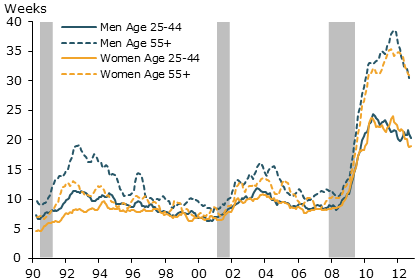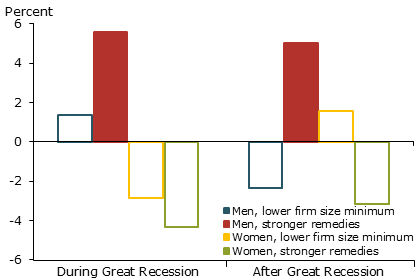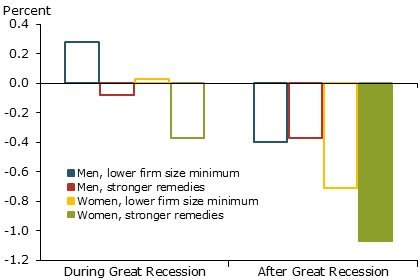The Great Recession led to large increases in unemployment rates and unemployment durations for workers of all ages, but durations rose far more for older workers than for younger workers. This difference was apparent both during and after the recession, fueling speculation that age discrimination played a role. Research indicates that in states with stronger age discrimination protections, older-worker unemployment durations increased more relative to increases for younger workers. This suggests that state age discrimination laws may need to be modified to strengthen protections during downturns.
The sharp increases in the duration of unemployment for older workers during and after the Great Recession indicate that older individuals who lost their jobs because of the downturn or who were seeking new employment have had a harder time finding work than other workers have. Increasing unemployment duration for older workers has led to speculation that age discrimination may have played a role. Increased discrimination during poor labor markets might be expected because long queues of job applicants allow employers to apply more arbitrary selection criteria when making hiring decisions.
Many states offer stronger protection against age discrimination than does the federal Age Discrimination in Employment Act (ADEA). Furthermore, research suggests that these stronger age discrimination protections helped older workers in the years before the Great Recession. For example, these antidiscrimination measures are associated with shorter unemployment durations and greater hiring rates for older workers. This Economic Letter explores whether these stronger state-level age discrimination protections guarded older workers during and after the Great Recession, especially unemployed older workers seeking jobs.
Analysis
We focus on two features of state age discrimination laws. First, state laws vary on the minimum number of employees an employer must have for age discrimination laws to apply. States with lower minimums have stronger laws since some employees are covered who are not protected by the federal ADEA, which applies only to employers with 20 or more employees. During our 2003–11 sample period, 34 states had lower employer size minimums.
Second, some state age discrimination laws provide for larger damages than the ADEA by allowing compensatory or punitive damages. Federal law only allows for more than liquidated damages, that is, the actual cost of damages incurred, in cases of willful violation. During our sample period, 29 states allowed larger damages under less strict standards. Research has found that these two types of stronger protections enabled older workers to remain employed longer and may have increased hiring (see Neumark and Song 2013).
The available data do not tell whether the extent of age discrimination after the Great Recession varied across states depending on their age discrimination laws. However, we can ask whether these state protections were associated with less adverse effects of the recession on older workers compared with younger workers.
Figure 1
Median unemployment duration in weeks

Notes: Gray bars indicate NBER recessions. Data are from Current Population Survey and are seasonally adjusted and weighted to be nationally representative.
Figure 1 shows the evolution of unemployment durations drawn from the Current Population Survey (CPS), a household survey conducted jointly every month by the U.S. Census Bureau and the Bureau of Labor Statistics. The CPS is the source of federal unemployment data and other well-known labor market indicators. We also analyze the Census Bureau’s Quarterly Workforce Indicators (QWI) data from all states for the period 2003–11. The QWI data come from a large sample of employee records matched to employer data, and track movements of workers into and out of businesses over time.
The federal ADEA applies to workers age 40 and over, while some state laws protect workers younger than 40. We study the age groups 25–44, which we designate younger workers, and 55 or older, which we call older workers, because of data constraints and a desire to focus on the most senior people in the workforce. We look at unemployment rates, employment-to-population ratios, median unemployment duration, and hiring rates, and conduct a statistical analysis to determine whether older workers in states with stronger age discrimination laws experienced less severe labor market disruptions during the Great Recession than younger workers.
Our statistical models control for other state-level factors that could have influenced these outcomes, including changes in the duration of eligibility for unemployment insurance benefits during this period. We also consider state differences in industrial composition to account for industry differences in employment by age group (see Neumark and Button 2013 for details). We estimate results separately for the period from the fourth quarter of 2007 to the second quarter of 2009, which roughly corresponds to the Great Recession, and the period immediately following the downturn from the third quarter of 2009 through the fourth quarter of 2011. We analyze these periods separately because labor market dynamics are quite different in them.
Figure 2
Changes in weeks unemployed, older vs. younger

Notes: Bars show differences in the effects of the Great Recession on median unemployment durations for older versus younger workers, compared between states with stronger and weaker age discrimination laws. Solid bars indicate estimates that are statistically significant at the 5% or 1% level.
Results
Figure 2 shows results for the unemployment durations of older and younger workers in states with stronger and weaker age discrimination laws during and after the Great Recession. The solid boxes indicate estimates that are statistically significant, meaning that it is very unlikely that we are incorrectly detecting an effect of state laws. We measure changes in the median unemployment duration in weeks for older workers relative to younger workers, comparing states with specific age discrimination protections and states that do not offer these specific protections.
Figure 2 shows no statistically significant effects due to age discrimination laws with lower employer size minimums. However, state with laws that allow larger damage awards have an additional 5.57 weeks of unemployment for older men relative to younger men during the recession, and an additional 5.04 weeks of unemployment after the recession. By contrast, in these states, the unemployment duration of older women increased by 4.35 weeks less than that of younger women during the recession. Following the recession, the unemployment durations of older women also declined in relative terms. Estimates for women during both periods are large, but are statistically insignificant.
Figure 3
Changes in hiring rates, older vs. younger

Note: See Figure 2.
Figure 3 compares hiring rates for older and younger workers under varying state age discrimination laws. The estimates represent the percentage point change in the rate of hiring. The only statistically significant result is that larger damages are associated with a 1.07 percentage point drop in the hiring rate of older women relative to younger women after the Great Recession.
The substantial relative increases in older-worker unemployment durations have prompted considerable speculation about age discrimination. In addition, the findings on hiring are significant because they may suggest that older workers experienced discrimination when seeking jobs (Neumark 2008). We also found that during the recession larger damages were associated with a reduction in the employment-to-population ratio among older women relative to younger women. After the Great Recession, larger damages were associated with increased unemployment rates among older men relative to younger men. Lower employer size minimums were associated with reduced employment-to-population ratios for older women compared with younger women.
Thus, we find no evidence that stronger age discrimination protections helped older male workers weather the Great Recession better than younger male workers. In fact, some evidence indicates that stronger state age discrimination protections may have made things relatively worse for older male workers. For women, the evidence is more mixed. On one hand, some evidence suggests that stronger age discrimination protections were associated with relatively smaller increases in the unemployment durations of older women during the Great Recession. On the other hand, in the period after the Great Recession, states with stronger age discrimination protections had larger declines in the hiring rate of older women.
Conclusion and interpretation
These results provide very little evidence that stronger state age discrimination protections helped older workers weather the Great Recession. In fact, the opposite may have occurred, with older workers bearing more of the brunt of the Great Recession in states with stronger age discrimination protections.
This evidence does not speak to the effectiveness of age discrimination laws during normal times. Some previous research indicates that the initial adoption of state and federal age discrimination laws increased employment of older men. Indeed, when we examined the effectiveness of state age discrimination laws in the years before the Great Recession, we found evidence of reduced unemployment durations for men and improved hiring rates for men and women. But why might the effectiveness of these laws vary at different points in the business cycle? We suggest some possible explanations:
- An event like the Great Recession disrupts the labor market so severely that sorting out which effects are due to age discrimination and which to worsening business conditions becomes very difficult. These complications may make it hard to demonstrate age discrimination, reducing the likelihood that the legal system can intervene effectively and fairly.
- States with stronger age discrimination laws impose constraints on employers. Thus, there could be what might be described as a pent-up demand for age discrimination in these states. A sharp downturn gives employers cover to engage in age discrimination.
- During and after the Great Recession, business conditions and the need for labor may have been so uncertain that employers became especially wary of hiring older workers. They may have feared that if they had to lay off older workers, they would face wrongful termination claims based on age. Such claims could be more likely or more costly in states with stronger age discrimination laws.
If these conjectures are correct, then as the economy recovers, stronger state age discrimination protections should become more effective in improving the labor market outcomes of older workers. Nonetheless, increased discrimination during and after the Great Recession may have extended unemployment durations of older workers, especially those near retirement. In that way, they might have prompted some older workers to hasten their exit from the labor force.
Finally, if age discrimination does increase during sharp economic downturns, then it may be useful to consider whether it is possible to modify age discrimination protections to maintain their effectiveness in times of economic turbulence. Possible modifications could include refinement of legal standards for discrimination that would make it harder to appeal to changes in business conditions. In addition, affirmative policies that would encourage hiring of older workers might be helpful.
David Neumark is Chancellor’s Professor of Economics and Director of the Center for Economics & Public Policy at the University of California, Irvine, and a visiting scholar at the Federal Reserve Bank of San Francisco.
Patrick Button is a Ph.D. candidate at the University of California, Irvine.
References
Neumark, David. 2008. “The Age Discrimination in Employment Act and the Challenge of Population Aging.” Research on Aging 31(1), pp. 41–68.
Neumark, David, and Patrick Button. 2013. “Did Age Discrimination Protections Help Older Workers Weather the Great Recession?” NBER Working Paper 19216 (July), forthcoming in Journal of Policy Analysis and Management.
Neumark, David, and Joanne Song. 2013. “Do Stronger Age Discrimination Laws Make Social Security Reforms More Effective?” Journal of Public Economics 108, pp. 1–16.
Opinions expressed in FRBSF Economic Letter do not necessarily reflect the views of the management of the Federal Reserve Bank of San Francisco or of the Board of Governors of the Federal Reserve System. This publication is edited by Anita Todd and Karen Barnes. Permission to reprint portions of articles or whole articles must be obtained in writing. Please send editorial comments and requests for reprint permission to research.library@sf.frb.org